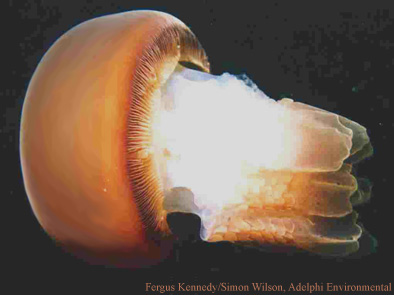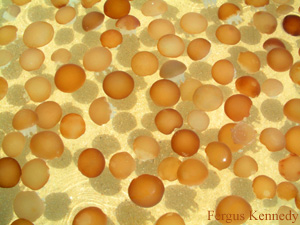
During the past couple of years, large swarms of jellyfish have bloomed in the Gulf of Oman. They have caused considerable concern in Oman, where they have blocked many seawater intakes, and in Iran, where they have hindered fishing. Bottom trawls (mesh-size 80 mm) targeting groundfish have returned catches comprising as much as 90% jellyfish (by weight; 10-15 cm bell diameter). The jellyfish are also commonplace in surface waters. Abundant jellyfish also have been reported from Yemen and the problem may be widespread in the Arabian Sea.

Results of a trawl in the Gulf of Oman.
Understanding jellyfish blooms has been hindered by a general lack of
knowledge of, for example, jellyfish ecology, historical patterns of
abundance, oceanography, and the effects of variation in local ecosystems
and changes in global climate. Understanding also has been hindered,
at least in this case, by the lack of a reliable identification of the
jellyfish, and it was in this context that the jellyfish and blooms
were brought to the attention of a wider audience via the cnidarian
newsgroup in late-2002. Since then, photographs and some morphometric
data exchanged via the internet have allowed us to tentatively identify
the jellyfish from Iran and Oman as Crambionella orsini. This
is consistent with the previously reported geographic range of C.
orsini, from the Red Sea to India, including the "Iranian Gulf"
(Kramp 1961). This suggests, therefore, that the problems may be attributable
to natural fluctuations of an endemic species rather than, say, recent
explosion of a weedy invasive.
Researchers
in Iran are gathering weather information and data describing the chemical
and physical oceanography of the region to investigate possible relationships
with the abundance of jellyfish in recent years. A more robust identification
of the species is also intended. Increased knowledge may alleviate some
of the concern about possible future impacts of the jellyfish on coastal
industries in the Arabian Sea. Certainly, a better understanding of
factors influencing their occurrence should allow measures to be put
into place that will mitigate detrimental effects. As C. orsini
is considered to be an edible jellyfish, there may even be a silver
lining.
